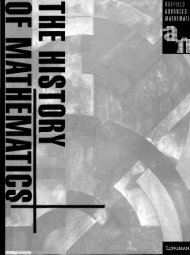Louis Pasteur by Nicola Kingsley - National STEM Centre
Louis Pasteur by Nicola Kingsley - National STEM Centre
Louis Pasteur by Nicola Kingsley - National STEM Centre
You also want an ePaper? Increase the reach of your titles
YUMPU automatically turns print PDFs into web optimized ePapers that Google loves.
Mer de Glace on<br />
Mont Blanc<br />
where <strong>Pasteur</strong><br />
carried out some<br />
of his<br />
experiments<br />
18<br />
over 200 miles and heading up into the Jura mountains<br />
with his assistants and a large supply of sealed flasks<br />
containing a sterile mixture of sugar, water and yeast<br />
extract-good food for microbes. At different heights up<br />
the mountains he carefully broke the necks of the flasks to<br />
admit fresh air, and then resealed them using a flame. The<br />
higher they went up the mountains, the fewer of the flasks<br />
exposed to air in this way grew any microbes. Because the<br />
air was so clean, especially right at the top among the<br />
glaciers, some developed no microbes at all. Once again<br />
<strong>Pasteur</strong> showed that fresh air alone was unable to give rise<br />
to microbes.<br />
Pouchet, too, was a fighter. He set off up another range of<br />
mountains, the Alps, to try the experiment, and he came<br />
back saying he had got different results. Every single flask<br />
he had opened developed microbes.<br />
<strong>Pasteur</strong> demanded that the Academy of Sciences repeat his<br />
experiments. He was completely sure his own results were<br />
correct, and he wanted Pouchet to be shown, in public, to<br />
be wrong. The experiments were done again, and the<br />
Academy announced their decision: <strong>Pasteur</strong> was right.

















